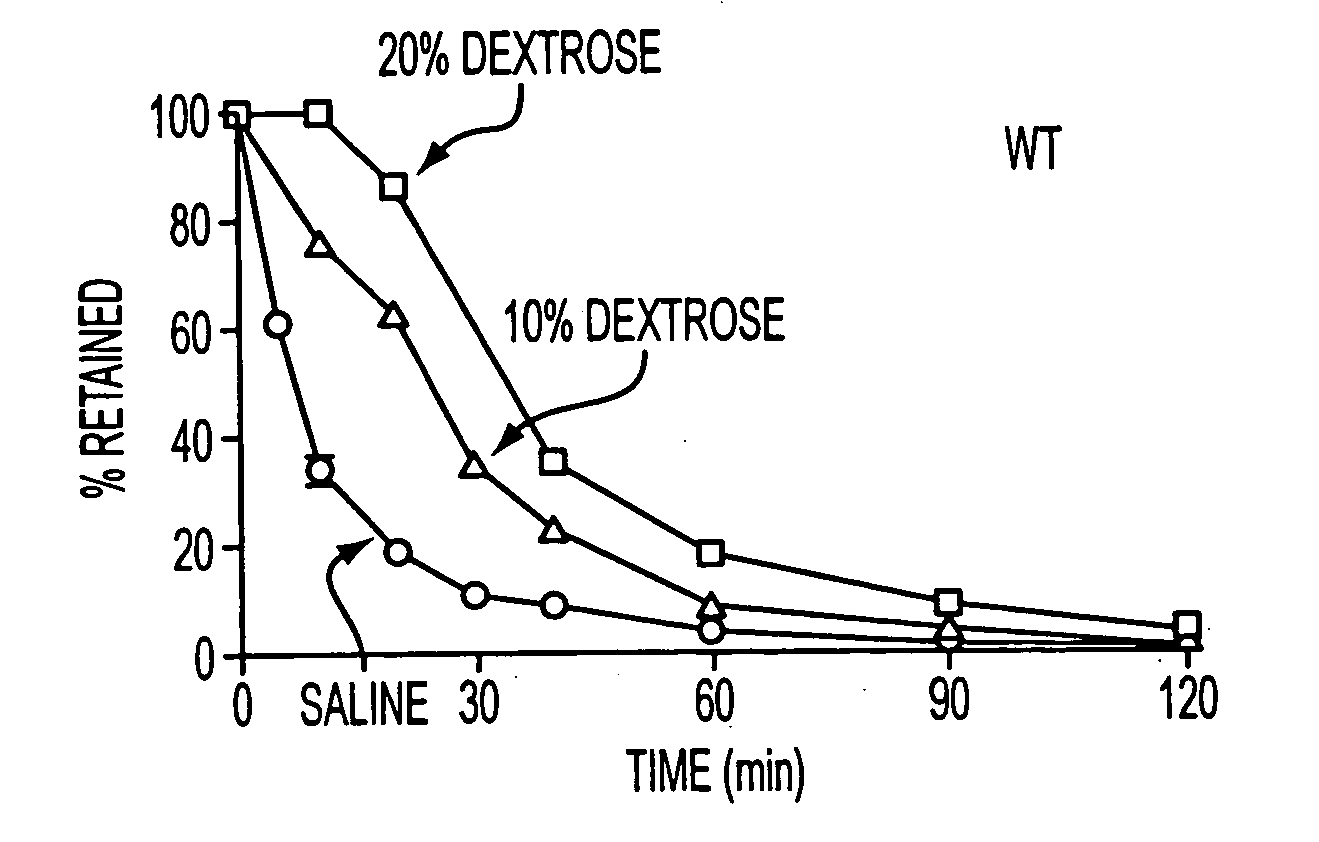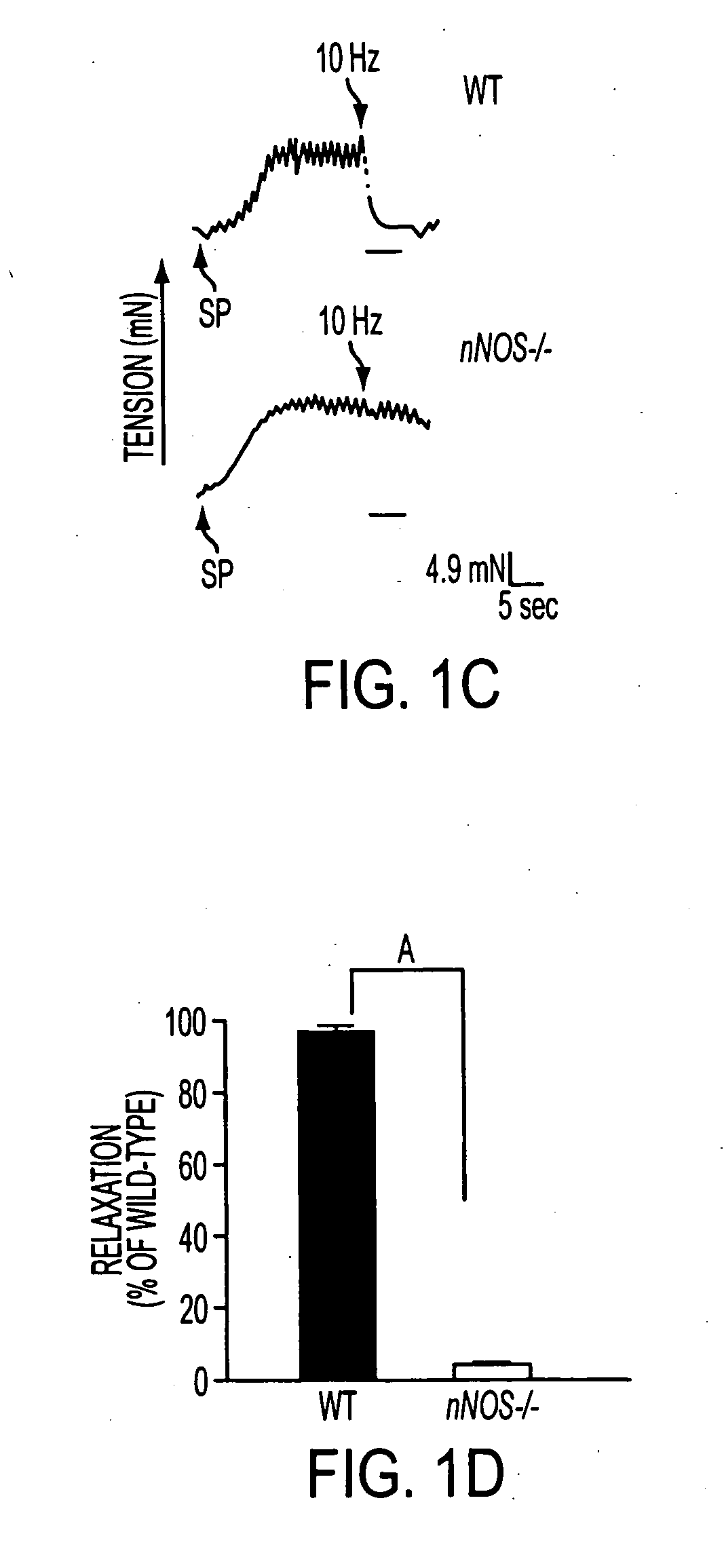Methods for prevention and treatment of gastrointestinal disorders
a gastrointestinal disorder and gastrointestinal disease technology, applied in the field of gastrointestinal disorders, can solve the problems of loss of key signaling components and negatively affect a wide range of cell functions, and achieve the effects of restoring no signaling, increasing no activity, and increasing the level of nnos enzym
- Summary
- Abstract
- Description
- Claims
- Application Information
AI Technical Summary
Benefits of technology
Problems solved by technology
Method used
Image
Examples
example 1
nNOS-1- mice Have Delayed Gastric Emptying and Lack Pyloric NANC Relaxation.
The pyloric hypertrophy and gastric dilation of nNOS-1- mice suggests a key role for NO in pyloric function (15). nNOS is expressed throughout the stomach, pylorus, and intestine (33-35), and all of these tissues contribute to the coordinated regulation of gastric emptying (10) in different ways. Thus, we wanted to determine the overall functional effect of genomic deletion of nNOS on gatropyloric physiology in nNOS-1- mice. To address this, a spectrophotometric method was adapted to measure gastric emptying of liquid meals in mice (30, 36). In these experiments, mice underwent oral-gastric intubation with a small catheter followed by instillation of a liquid containing a known quantity of phenol red. At appropriate times thereafter, the phenol red remaining in the stomach was quantified spectrophotometrically. Saline empties rapidly with at t1 / 2 of 8 minutes, whereas 10% and 20% dextrose empty more slowl...
example 2
Diabetic Mice Have Delayed Gastric Emptying and Decreased NO-dependent NANC Relaxation Similar to Those of nNOS-1- mice.
The delayed gastric emptying observed in the nNOS-1- mice is similar to human diabetic gastropathy (4-6, 37-39). In addition, previous reports have suggested that nNOS expression may be altered in diabetic rates (25-27). To ascertain whether nNOS plays a role in diabetic gastropathy, gastropyloric function was evaluated in two models of diabetes in mice. NOD mice develop diabetes spontaneously, around 14 weeks of age, through autoimmune destruction of the pancreatic B cells (40). Thus, young NOD mice (NOD prediabetic) have normal insulin and glucose levels, although older NOD-diabetic mice have insulin-deficient diabetes. A second model of diabetes in mice uses STZ, a toxic glucose derivative selectively taken up by pancreatic B cells (29). We induced diabetes with a single injection of STZ (200 mg / kg; as discussed in Methods) and studied the gastropyloric funct...
example 3
nNOS-1- protein and mRNA Expression is Lost in Diabetic Mice.
Since diabetic and nNOS-1- mice have similar abnormal gastropyloric physiology, we wondered whether nNOS expression is altered in diabetic pylori. Thus, we examined the expression of the nNOS protein by immunohistochemistry and nNOS mRNA by in situ hybridization. Immunohistochemistry reveals discrete staining for nNOS in myenteric neurons in wild-type (FIG. 4a) and NOD-prediabetic pylon. Staining is absent in nNOS-1- mice (FIG. 4a), confirming the antibody's specificity. nNOS staining is nearly abolished in NOC-diabetic and substantially reduced in STZ-diabetic pylori (FIG. 4a). To quantify these changes, we determined the number of nNOS-positive neurons per high power field (hpf). nNOS-positive neurons are reduced about 65% in the STZ-diabetic pylori and by about 80% in the NOD-diabetic mice (FIG. 4b). In situ-hybridization reveals markedly decreased nNOS mRNA expression in nNOS-1-, NOD-diabetic, and STZ-diabetic pylor...
PUM
| Property | Measurement | Unit |
|---|---|---|
| time period | aaaaa | aaaaa |
| time | aaaaa | aaaaa |
| signal transmission | aaaaa | aaaaa |
Abstract
Description
Claims
Application Information
 Login to View More
Login to View More - R&D
- Intellectual Property
- Life Sciences
- Materials
- Tech Scout
- Unparalleled Data Quality
- Higher Quality Content
- 60% Fewer Hallucinations
Browse by: Latest US Patents, China's latest patents, Technical Efficacy Thesaurus, Application Domain, Technology Topic, Popular Technical Reports.
© 2025 PatSnap. All rights reserved.Legal|Privacy policy|Modern Slavery Act Transparency Statement|Sitemap|About US| Contact US: help@patsnap.com



